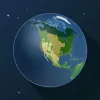
Digital Citizenship Week is October 20–24!
Join teachers worldwide to promote a healthy, positive approach to media and tech.
Take a look inside 5 images
BiomeViewer
Pros: Includes an attractive interface, sharing options, and tons of data that's easy to access.
Cons: Extension materials are limited, there's no in-app help, and zoom could have better resolution.
Bottom Line: This biome reference app helps students get local when understanding their planet Earth.
BiomeViewer is a very useful reference for all subjects relating to world geography. It touches on physical geography, but its strengths lie in ecosystems and world climate data. The app includes an Educator Guide with several ideas of how to use it in the classroom, and teachers can also follow the links to HHMI BioInteractive's online resources, including documentaries, lectures, virtual labs, classroom resources, and educator guides. Some of these are more relevant to their other apps but take some time to peruse their site to see if what they offer would work in your classroom.
Another way teachers can use BiomeViewer is for open-ended discovery for students. Have them compare areas that are near each other and then areas that are far apart. Comparing a city in the Sahara Desert and one in the Brazilian rainforest, for example, will elicit gasps from students when they compare the annual temperature curve and rainfall amounts. Have students compare your town and far-off locations they've visited. Compare how the Earth looks when in globe form versus on a flat map. Seek out endangered wildlife and see how that relates to the area's anthrome data. Challenge students to find specific cities on the Earth without the political boundaries shown. Students will have fun playing with the app for a while, and then they can settle down and use the included data and visuals for more research activities.
BiomeViewer is a reference app about planet Earth. It covers a myriad of data for the entire planet, including ecosystems and biomes, wildlife, climate, photos, and more. On the left of the screen you'll find the controls for seeing the world's biomes and their descriptions, anthromes (where you can see patterns of human development from 1700 to 2000), average temperatures and precipitation of the planet for each month of the year, and the Earth's terrain map. This can all be viewed with the Earth as a globe or on a flat map, with or without political boundaries or grid lines shown. For precipitation and temperature, students can also tap the play button to animate the changes through the year. On the map, students can pinch in or out to zoom, though the resolution doesn't improve as you zoom in.
Students can tap on the map -- or search by location or latitude/longitude -- to see the climate data, wildlife, and biome description for specific places. These locations can be saved, which then show up as stars on the bigger map, making them easier to access. There are extended descriptions and photos for every major biome on each continent: wildlife data and photos for over 16,000 species, historical world climate data, and maps of human effects on ecosystems. Students can also compare two locations' data side by side. Certain kinds of reports can be exported, and information about locations can be shared.
BiomeViewer is fantastic for learning when used for either open-ended exploration or as a reference with more formal lessons. Students can seek out their hometowns and compare climate data, biomes, and wildlife with other places on the planet. They can look more closely at the wildlife, checking out a series of photos and filtering by endangered status. By being able to compare two locations side by side, students get a much better idea of the drastic contrasts of our planet. If they have the app on their own tablet, students can save their favorite locations. It's easy to collaborate using this app as well; reports can be generated for biomes and shared. Climatogram images can also be shared, either for a single location or for a comparison between two locations. Though the information provided in the app isn't deep, it's thorough. The information is somewhat buried in the app, but students can truly learn quite a lot about wildlife throughout the world.
BiomeViewer is a wonderful tool, especially for the (free) price, though there's some room for improvement. Future versions could have improved resolution when zooming, climate data for more places (some large cities didn't have any information), auto-fill when typing in a city name, and being able to search by animal or by temperature or rainfall constraints. More up-to-date climate data would be nice as well since it only uses averages up to 2000.














